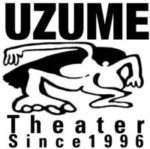→Japanese page
Written by Ren Saito
Direction by Peter Goessner
Performance date: October 1996
Place of performance:Nakajyuku Hachimangu Shrine (Kitakyushu City)
Author; Yoko Matsuo
Date of writing; October 2016.
When the flagship production of “My friend Hitler” was finished, some of the actors and staff members who had participated in it wanted to do another play with Peter’s direction.
The Uzume Theatre itself was in a precarious position with only one director and actor, so when the idea of putting on a joint performance with theater group “Red Ginger”, Kyoko Yamaguchi who had played Hitler was president, was suggested, I think he delighted.
At that time, Peter wanted to do a play in a tent.
During his first three years in Japan in 1993, he traveled around the country to see Japanese plays, and when he visited the Black Tent theater company in Tokyo, someone gave him a theater magazine called “Dōjidai Engeki” (later turned out to be Natsuko Kiriya) . At the time, Peter was enrolled at the University of Leipzig as a working student and his master’s thesis theme was “Japanese Underground Theatre”. He was very interested in Japan’s unique theatrical style and wanted to do an underground play (preferably in a tent) as well.
However, no one, including myself, had any experience in tent theater, so after much deliberation, we decided to do an outdoor performance, but something no one else had ever done before.
The venue was the precincts of Nakajuku Hachimangu Shrine in Yahata-Higashi Ward. The shrine’s priest agreed to help us out, because Kyoko Yamaguchi had extensive friendships.
The question is, what are we going to do? At the time, I received a list of plays translated into English from the Playwrights’ Association of Japan, and I selected the plays from that list.
I selected the play “Akame” by Ren Saito.
The play “Akame” was a lot of work, but it was a lot of fun.
The era of that play was the Showa era. when television had just emerged, and a manga called “Akame” by Sanpei Shirato was used as a play within a play. We passed ropes to two sacred trees at the shrine, and there was an action scene where the ninja actor slid across the ropes in a pulley. This was largely thanks to the leadership of the firefighters who participated as actors in the scene. We also had to change stages using a weelbarrow, and during the scene of the peasant revolt, we had to fight with burning torches. During intermissions, actors dressed as peasants peddling drinks and food to the audience. The content of the play, which depicts a time of transition and the sadness of the loss of things, combined with the shrine’s borrowed scenery to create a play filled with the real joy of being outdoors.
On the other hand, there were many challenges to overcome in terms of audience construction, lighting, sound, etc., but afterwards I met Peter’s friends who supported the Uzume Theatre for a long time. Mr. Yoshiaki Furumura of Furumura Komuten, who offered to build the auditorium at a reasonable price. Asahi Shokai, who took care of the lighting under unfavorable conditions. An acquaintance of Kyoko Yamaguchi donated a large quantity of old kimonos from her warehouse, and we were able to make the peasants look stunning.
Also, while creating this play, we were able to see a little bit of Peter’s backbone.
Coming from the former East Germany, he witnessed the moment the Berlin Wall came down. That’s when I decided that I wanted to see the outside world, and when his wife took a job as a German lecturer at the Kyushu Institute of Technology, we came to Japan with our 3-year old daughter and no one we knew as a family. I thought there would be jobs in the theater if I came to Japan, but the situation in the theater was so different from Germany and there were no theater jobs at all, I was in despair.
As a bonus, Ms. Ren Saito came to see the production and said that Gessner was one of the top five directors in Japan, which surprised and made me very happy.
